This queso fresco recipe is made with only 4 ingredients and it doesn’t need rennet to make it. The result is a delicious fresh cheese perfect to crumble over your tacos, chilaquiles, and even salads!
What is Queso Fresco?
Queso fresco is a popular fresh cheese and a staple in Mexican cuisine. This cheese has a soft, moist, and crumbly texture with a mild flavor, a little bit tangy, and slightly salty.
The traditional queso fresco recipe is made mainly with cow’s milk and sometimes with a mixture of goat and cow’s milk. It is curdled with acid, like lemon juice or vinegar, unlike other types of cheese that are made with rennet.
It is a dairy product widely used in Mexican gastronomy, especially to crumb it over tasty antojitos (snacks) like enchiladas, but also to make other dishes like soups, salads, and sandwiches.
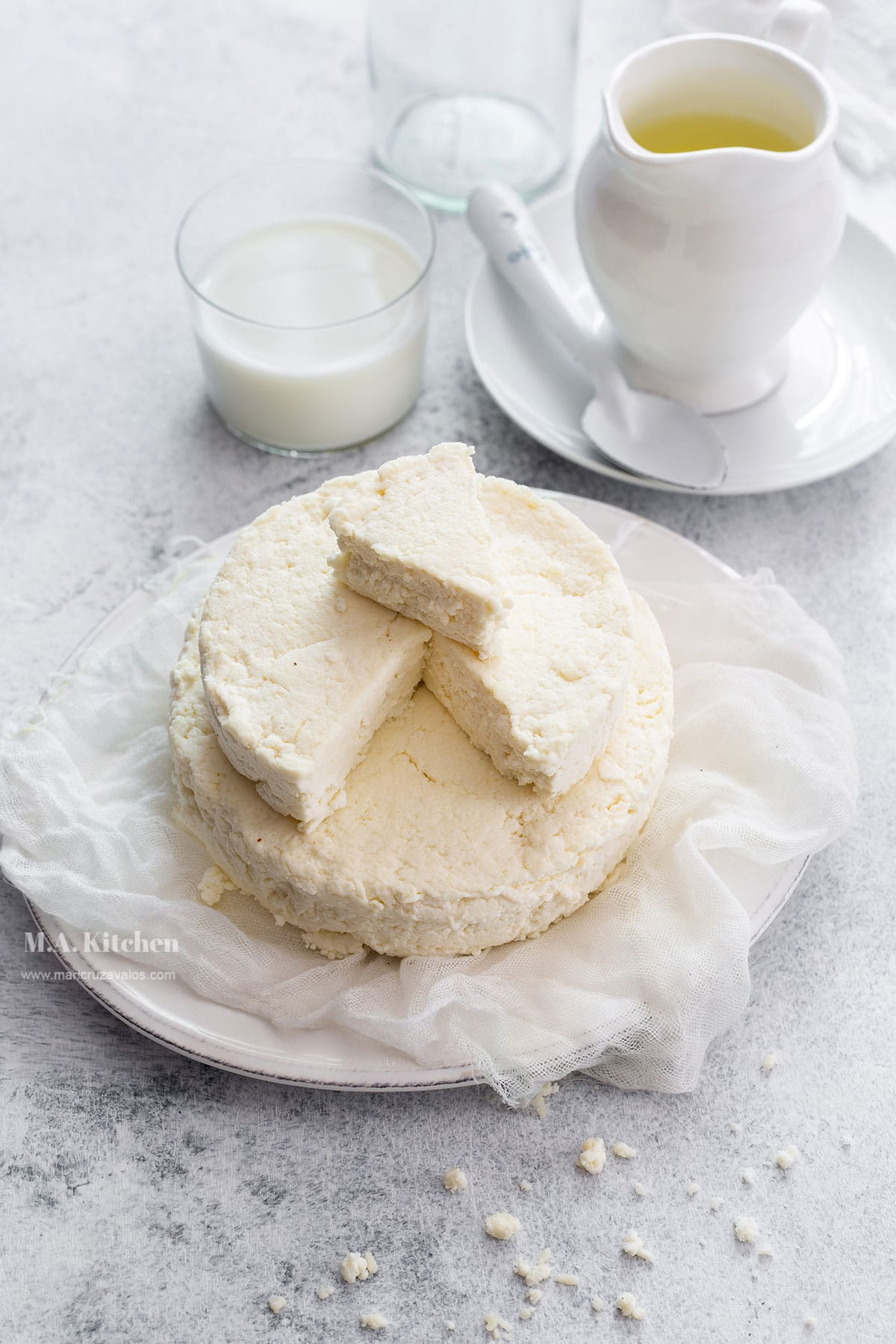
Our recipe for making this Mexican crumbling cheese doesn’t use rennet, as there are other types of ingredients that are perfect for curdling, let’s see what do you need to make it:
Ingredients Needed
- MILK – Use store-bought whole milk and avoid using low-fat milk or any vegetable beverages such as almond milk, soy milk, etc.
- YOGURT – Greek yogurt gives a nice texture and helps make the curd, but it’s totally optional. If you not adding the yogurt, add one extra tablespoon of vinegar.
- VINEGAR – White vinegar or apple cider are both good options.
- SALT – Any type of salt, I prefer sea salt.
Utensils you will need
- A large pot where you can place 1 gallon (4 liters) of milk or more.
- A digital thermometer for an accurate reading. It can be done also without it, just pay special attention to when the milk will be ready to boil.
- A medium bowl to place the colander over.
- A large colander to place the curd to drain off the excess whey.
- Cheesecloth. If you don’t have one, also a cotton kitchen cloth or paper kitchen towels works fine.
Homemade Queso Fresco Recipe
Place the milk in a large pot. Heat it until the milk is about to boil, that is, between 178°F to 190°F (80°C and 90°C).
If you do not have a thermometer, you will notice that the milk begins to form some little bubbles around the edges of the pot before boiling, that would be the exact moment that is called “to the point of boiling”.
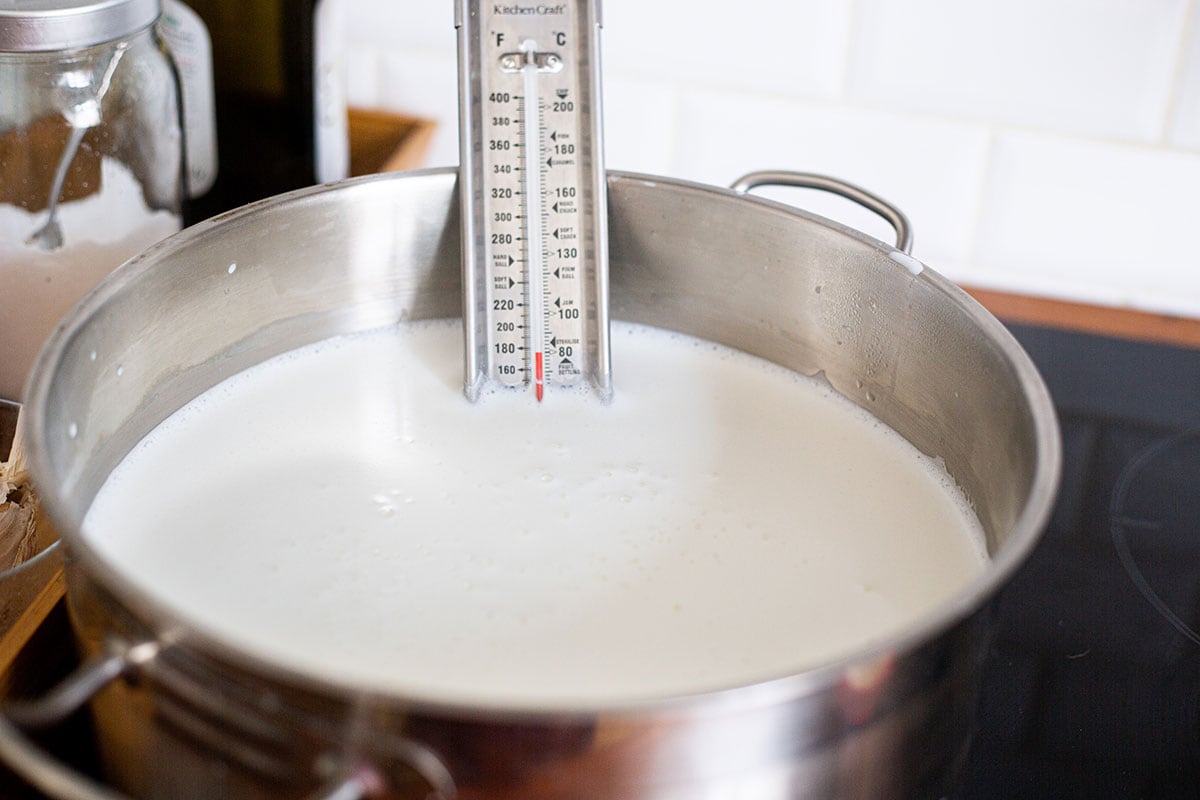
Turn off the heat and then add the yogurt. Stir for 10-15 seconds and let it sit for 2 minutes.
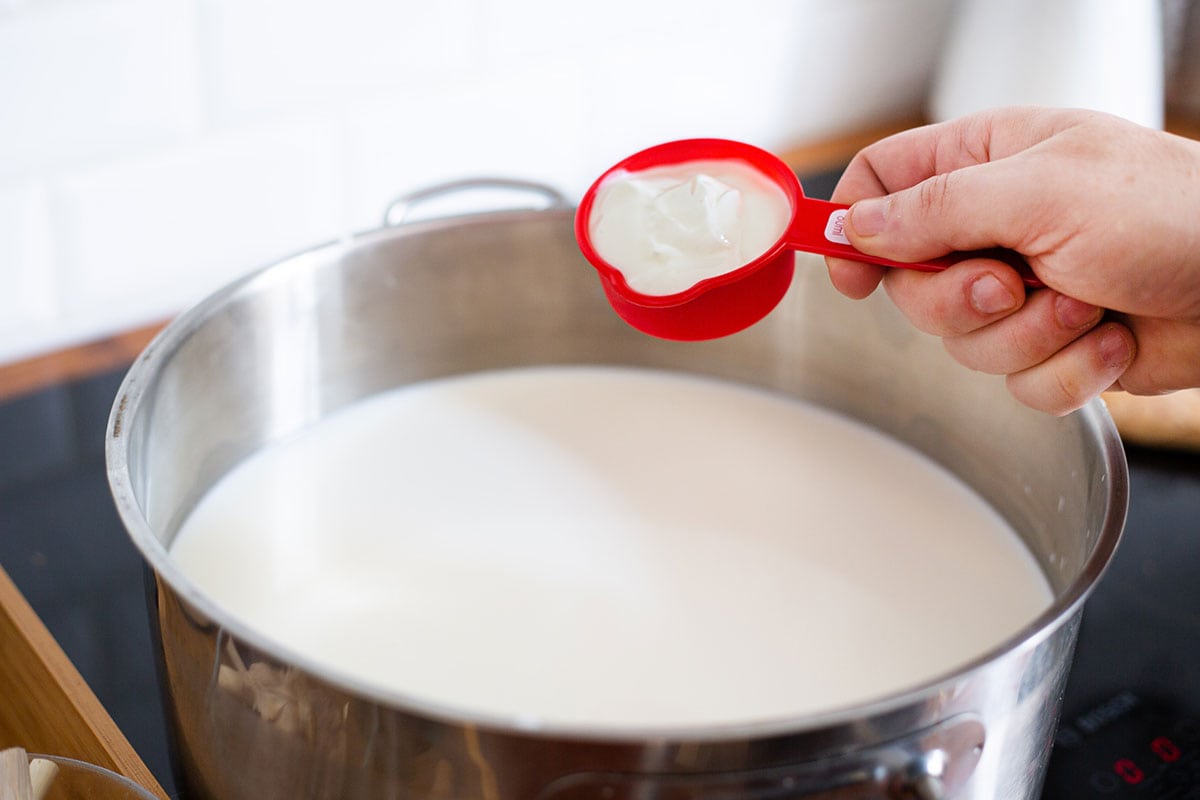
Add half the vinegar and mix again for 10 seconds. Then let it sit for another 2 minutes. Stir in the other half of the vinegar and mix slowly for one minute.
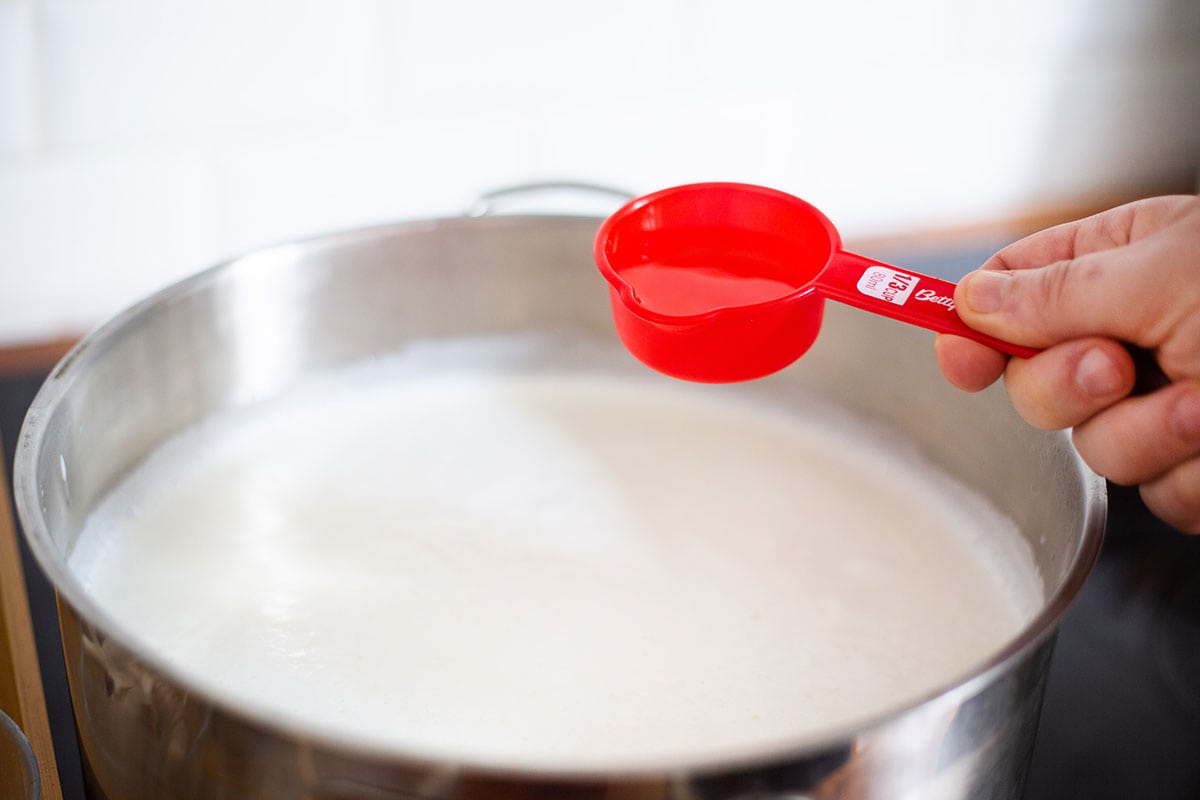
After that, you will notice how the milk has become a curd and has started to separate from the whey. Set aside until it reaches room temperature (about 1 hour).
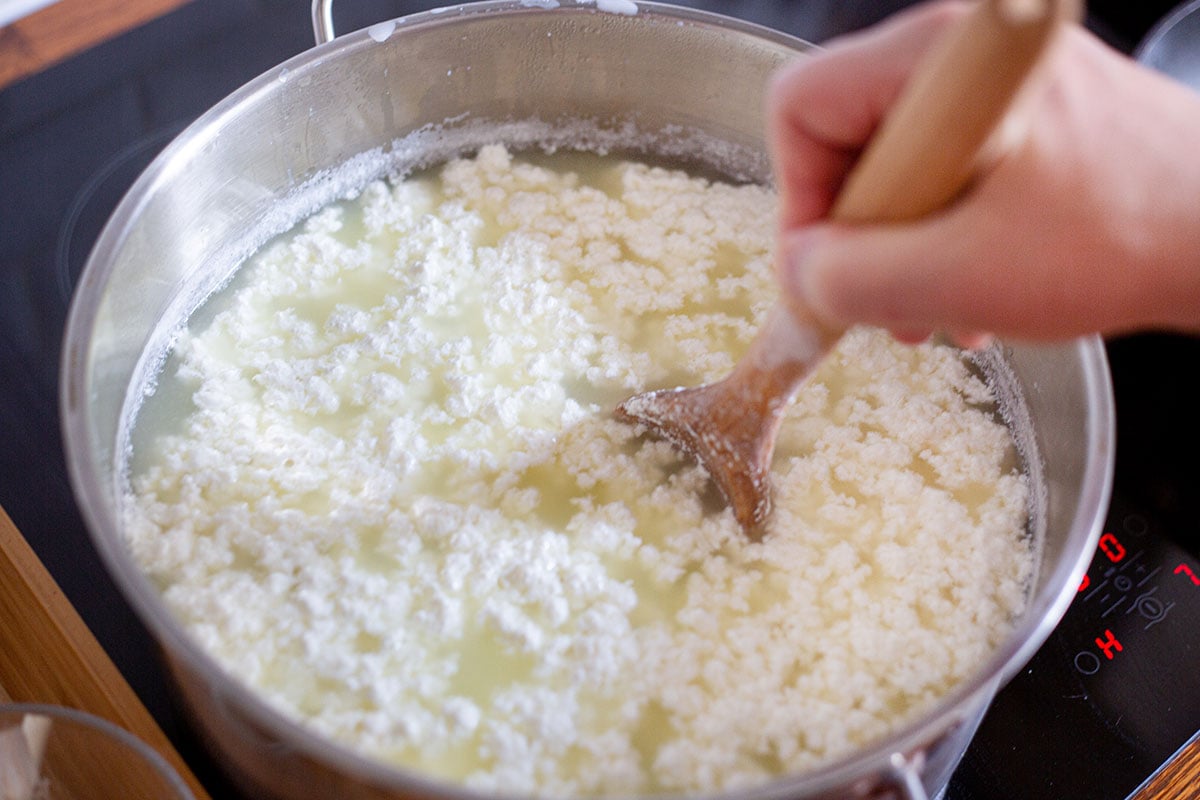
Line a large colander with 2 layers of cheesecloth or a clean kitchen towel and place it over a large bowl.
With a slotted spoon, transfer curds to the prepared colander.
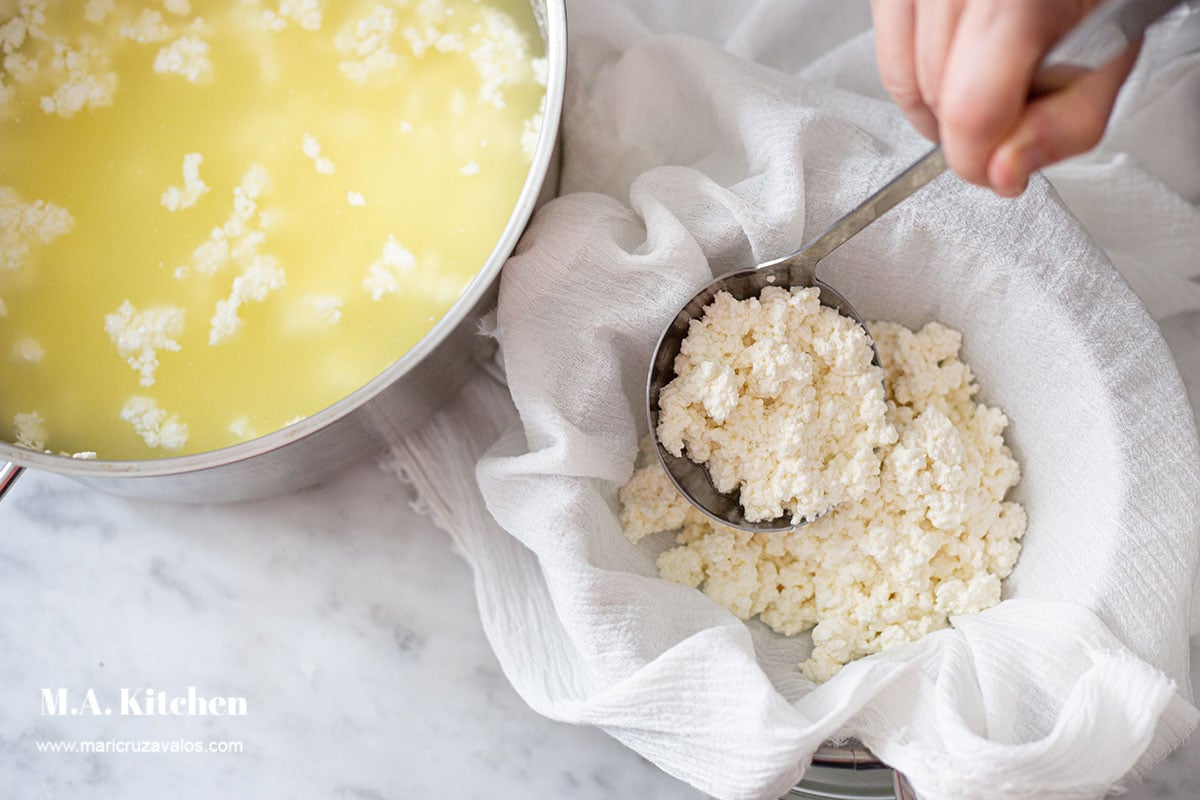
cover the exposed top with cloth, and allow to drain for about 20 minutes.
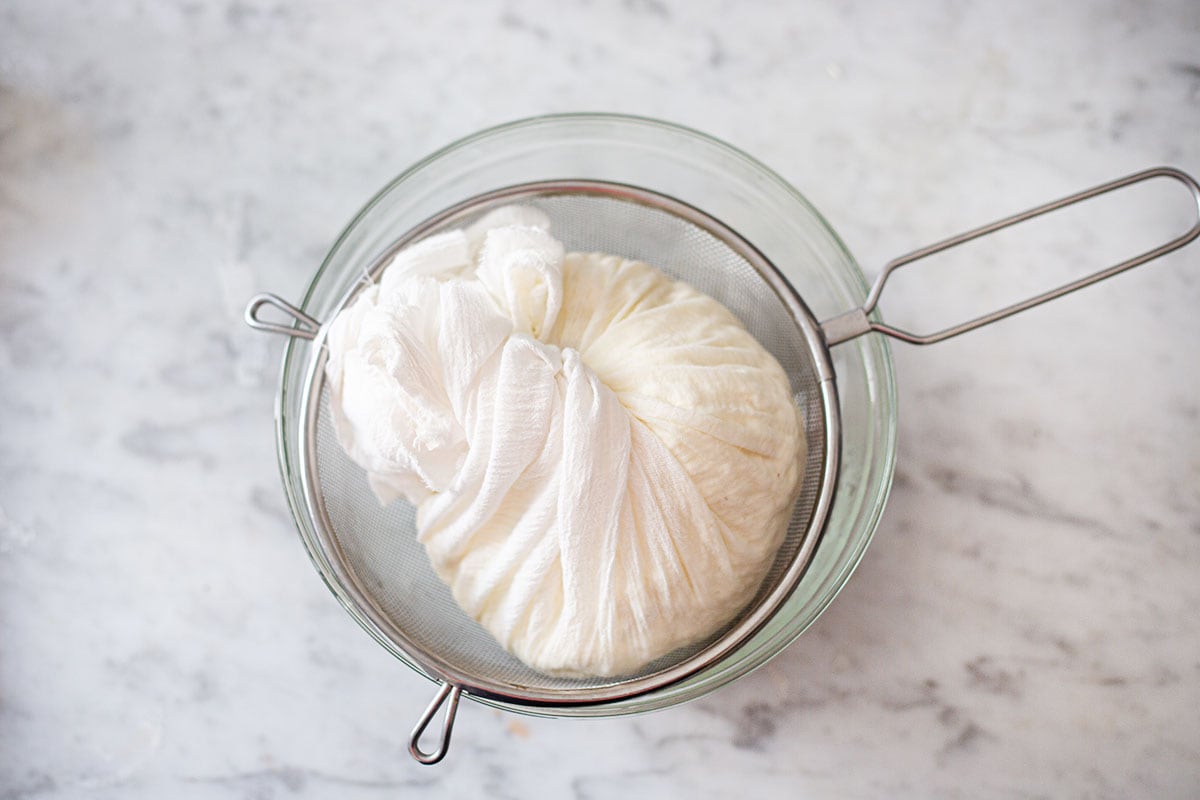
When most of the whey has drained off, lift the edges of the cheesecloth up and twist, wrapping the cheese into a ball, then carefully squeeze off excess whey.
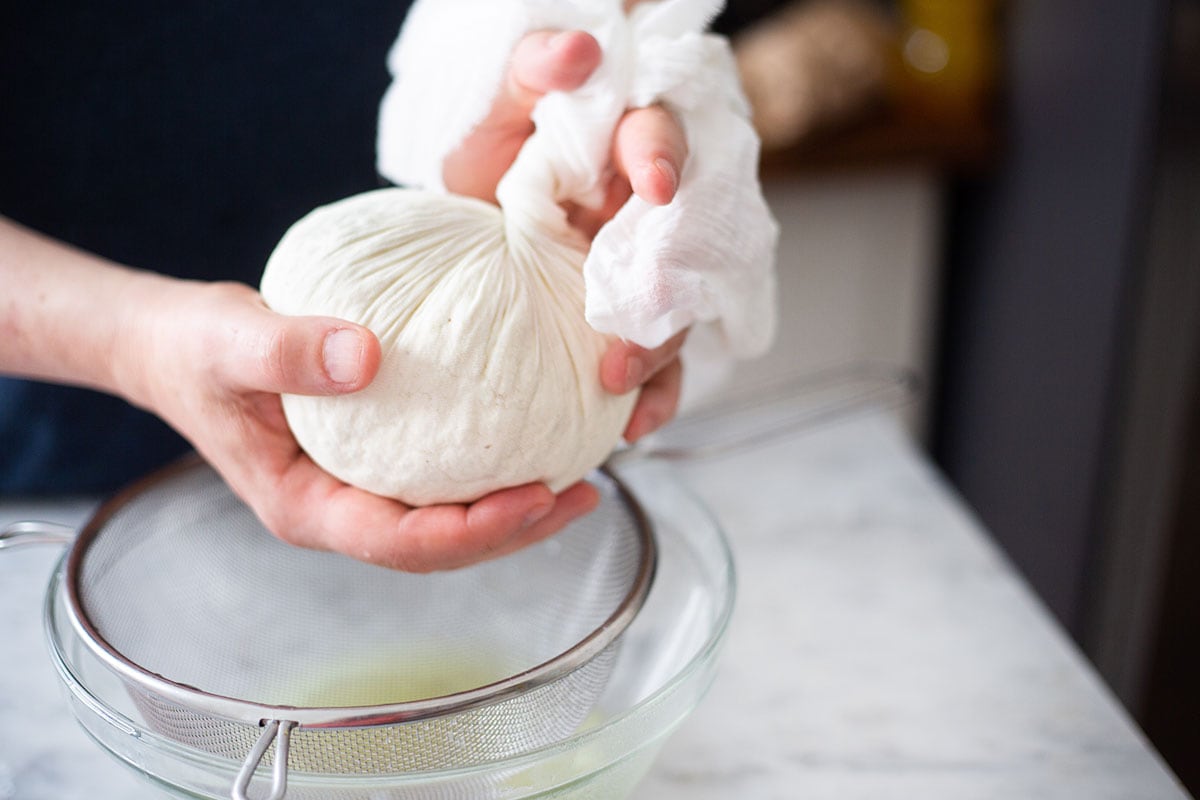
Place the cheese on a container and add salt to taste. Mix well with a wooden spoon but try to not overmix otherwise you’ll end up with cream cheese.
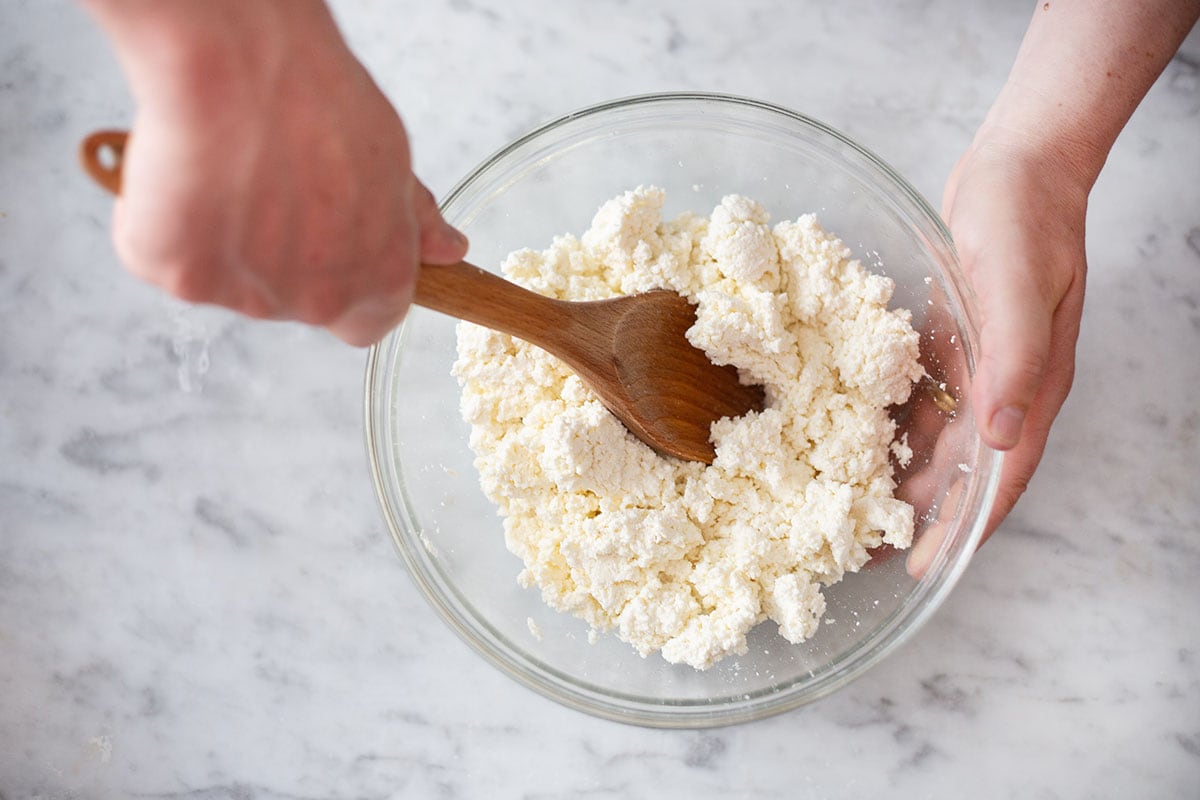
Now is the time to shape. You can use cheese molds (from Amazon), I used some cookie cutters I had, but also a regular bowl can work just fine.
Make sure you don’t press too hard or the cheese will get too compacted and won’t be as crumbly as it’s supposed to be.
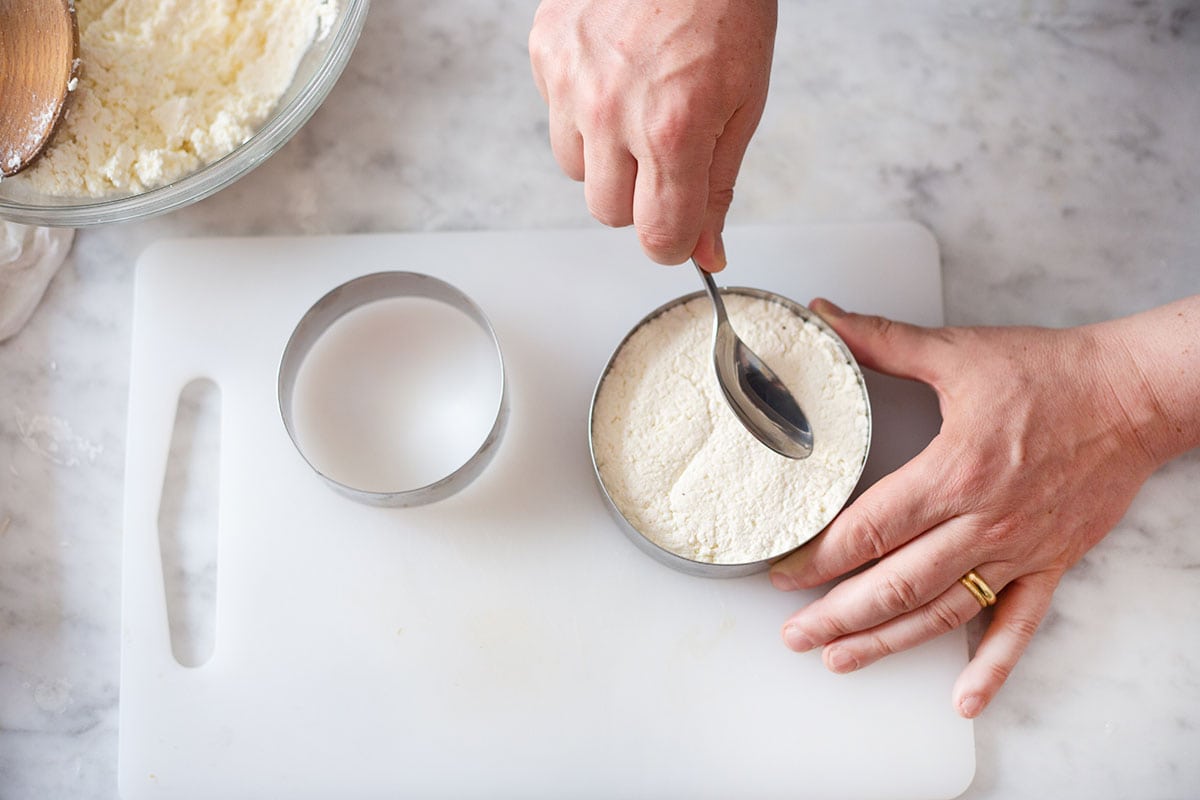
Place the fresh cheese in the refrigerator and let it sit for a couple of hours before consuming it. I recommend allowing to rest overnight.
Useful Notes
- If it’s the first time you make this Queso Fresco recipe, you might notice that the cheese is a bit creamy (like cream cheese); this may be for several reasons. For example, overmixing when seasoning with salt or pressing so hard when shaping.
- Making Queso Fresco with the exactly crumbly texture as the store-bought version takes a bit of practice. The first few times it will tend to be creamy, other times it will be a little crumbly (like cottage cheese). The important thing is the taste. So don’t get discouraged and keep trying until you’ll reach the texture you prefer.
- You can omit the yogurt if you want, just add one more tablespoon of vinegar or 1 tablespoon of lime juice.
- I’ve noticed that when I don’t let the curds cool completely, the cheese tends to get creamy, so it’s important to let it cool completely if you want a cheese that crumbles well.
- If you thinking of using raw milk to make this Mexican crumbling cheese, please read first this article: Drinking Raw Milk. Do Its Benefits Outweigh The Dangers?.
How To Use It
Once you make this queso fresco recipe you have lots of options to use it. Let’s see a few:
- TACOS: Crumble it over beef tacos dorados or stuff it into zucchini blue corn tacos.
- TOSTADAS: Add on top of a chorizo tostada or make our delicious chicken tostadas.
- STREET FOOD: From popular picadillo sopes, to traditional huaraches or garnachas. You can also stuff it into a pambazo sandwich.
- STEWS & SOUPS: Make this queso con chile rojo, garnish this amazing sopa de tortilla or use it to make this comforting caldo de queso.
- BEANS: Use it to eat with frijoles de la olla and warm tortillas, or crumble it over frijoles puercos for a tasty appetizer.
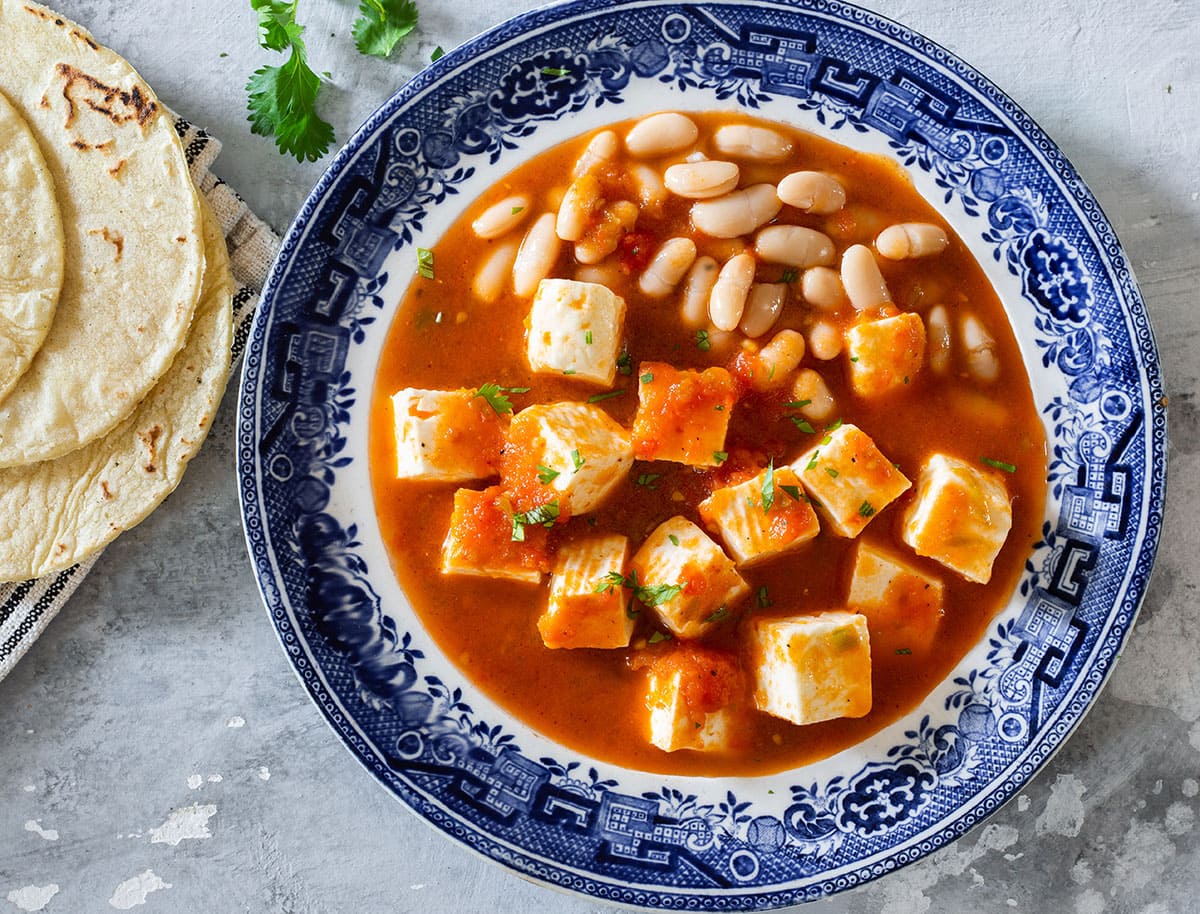
How To Store
This queso fresco recipe yields about 1 ½ lb (740 gr) of fresh cheese, so you might need to store it. Let’s see how:
- Fridge: Place the cheese in a glass container with a loose cover and store for up to 4 days in the coldest spot in the refrigerator.
- Freezer: Cut the cheese into small portions, then wrap it in parchment paper or cling film and place it in a proper container or a zip bag. Store for up to 3 months.
- Thaw: For a couple of hours or overnight in the fridge until soft and crumbly again, then use it.
TIP: You can also save some whey from the preparation and immerse the cheese in it. This will help to preserve the cheese fresh for another couple of days.
FAQ
Is Queso Fresco The Same As Cotija?
No. Cotija is an aged cheese with a saltier and stronger taste, while the former is a fresh cheese.
Can this cheese melt?
No. It can get soft when heated, but won’t be good for making quesadillas or melty casseroles.
What is similar to this cheese?
You can substitute queso fresco with feta, farmer’s cheese, paneer, or queso blanco (white cheese). For a vegan alternative, tofu is a great option.
Is this cheese healthy?
Compared to other types of cheese, this Mexican crumbling cheese is also relatively low in fat and salt, making it a great choice for people looking for healthier alternatives.
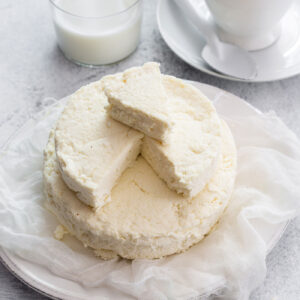
Queso fresco recipe
Ingredients
- 1 gallon whole milk (about 4 L)
- ⅓ cup greek yogurt (optional, about 80g)
- ⅔ cup white vinegar (160 ml)
- salt (to taste)
Instructions
- Heat milk in a large pot over medium-low heat, stirring frequently, until it registers between 178°F to 190°F (80°C to 90°C) on the thermometer. (see notes)
- Turn off the heat and add the yogurt. Stir for 10-15 seconds and let sit for 2 minutes.
- Add half the vinegar and mix again for 10 seconds. Then let it sit for another 2 minutes.
- Stir in the other half of the vinegar and mix for one minute.
- Set aside until it reaches room temperature (about 1 hour), so the curd will form.
- Line a large colander with 2 layers of cheesecloth or a clean kitchen towel and place it over a large bowl.
- Transfer curds to the colander, cover, and allow to drain for about 20 minutes.
- When most of the whey has drained off, lift the edges of the cheesecloth up and twist, wrapping the cheese into a ball; then carefully squeeze off excess whey.
- Place the cheese on a container and add salt to taste. Mix well with a wooden spoon (read notes).
- Now shape the cheese using molds (I used cookie molds) or use one or two bowls.
- Place Queso Fresco in the refrigerator and let it sit for a couple of hours or overnight before eating.
Notes
- This recipe yields 740 gr (about 1 ½ lb) of fresh cheese.
- If you do not have a thermometer, you will notice that the milk begins to make little bubbles around the edges of the pot, that would be the exact moment when you need to add yogurt and vinegar.
- I’ve noticed that when I don’t let the curds cool completely, the cheese tends to get creamy, so it’s important to let it cool completely if you want a cheese that crumbles well.
- If it’s the first time you make the Queso Fresco recipe, you might notice that the cheese is a bit creamy (like cream cheese); this may be for several reasons. For example overmixing when seasoning with salt or pressing so hard when shaping.
- You can omit the yogurt if you want, just add one more tablespoon of vinegar.
- Making Queso Fresco with the exactly crumbly texture from the store-bought version takes a bit of practice. The first few times it will tend to be creamy, other times it will be a little crumbly (like cottage cheese). The important thing is the taste. So don’t get discouraged and keep trying until you’ll reach the texture you prefer.
Nutrition Information
DID YOU ENJOY THIS QUESO FRESCO RECIPE? Please, don’t forget to rate it and leave us a comment below.


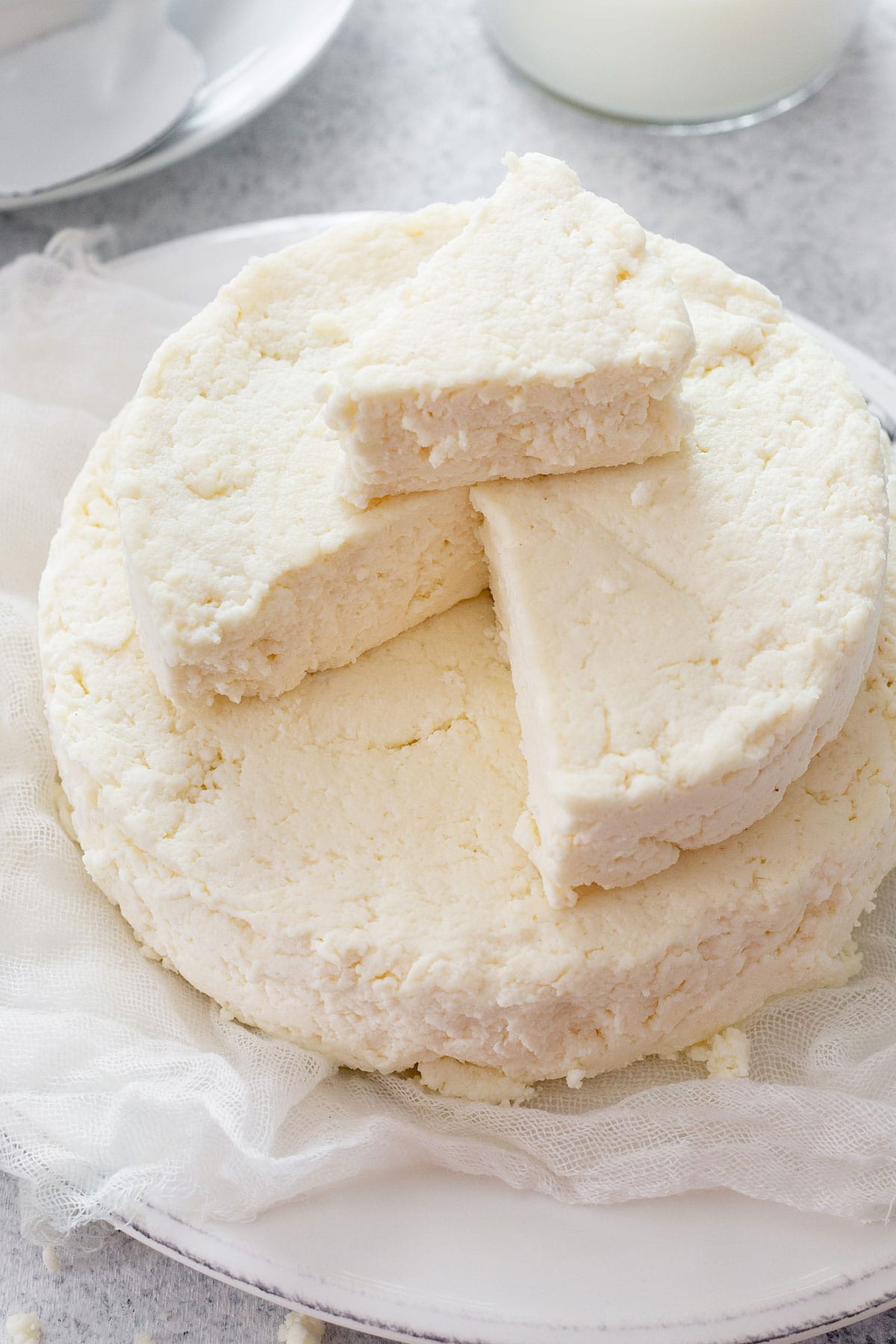
Hello Maricruz,
Thank you for sharing your recipe. I made your cheese today and it is perfectly delicious and crumbly. I am so pleased with the results. Your
Notes” were very helpful. My hubby and I both love it.
Hi Darlene, happy you liked the recipe! :)
i’m so making Queso fresco ! it seems appetizing. .